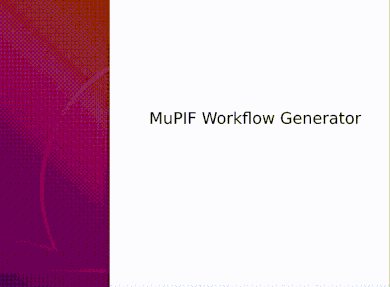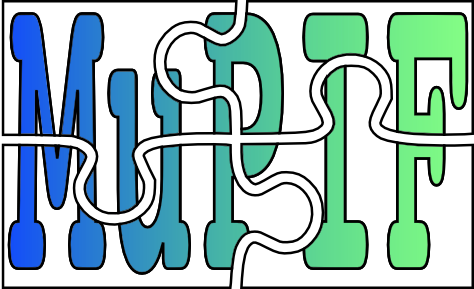This is an old revision of the document!
Table of Contents
MuPIF
MuPIF is modular, object-oriented integration platform allowing to create complex, distributed, multiphysics simulation workflows across the scales and processing chains by combining existing simulation tools. MuPIF uses Python 3.5 standards and is independent on operating system (Linux, UNIX, Windows, Mac, …).

MuPIF highlights
- Design based on interacting, distributed components (objects).
- Components are encapsulation of data, metadata and related services. In MuPIF components repsent models, workflows, and data (such as properties, spatial fields, microstructures, etc.)
- Instead of trying to standardize data structures, MuPIF is focused on identification and standardization of services on component classes
- Each generic class (model, workflow, complex data types) represented by abstract class which defines abstract interface (set of standardized services)
- Interfaces allow to communicate with any object using generic services, hiding the particular implementation details and allowing plug-and-play architecture
- Data, metadata and services (algorithms) operating on data encapsulated in a component are exchanged between applications → Models will get data and operations on data in one consistent package, do not have to interpret data themselves
- MuPIF components can be local as well as remote objects → distributed workflows, distributed data, enabling business model based on software or data as service and marketplaces integration
- MuPIF supports SSL or VPN based secure communication and data exchange
- Interfacing to commercial, closed source as well as open source simulation tools and databases. Graphical workflow editor
Framework Design
A reliable multiscale/multiphysics numerical modeling requires including all relevant physical phenomena along the process chain, typically involving multiple scales, and the combination of knowledge from multiple fields. A pragmatic approach lies in combining existing tools, The approach followed in MuPIF is based on an system of distributed, interacting components designed to solve given problem. The individual components represent different entities, including individual simulation packages and simulation workflows, high level data, external databases, etc. The top-level abstract classes are introduced covering all entities in the model space, defining common interfaces that need to be implemented by any derived class, representing particular implementation of specific component. Such interface concept allows using any derived class on a very abstract level, using common services defined by abstract class, without being concerned with the implementation details of an individual software component. This essentially allows to manipulate all models, data, and workflows using standardized interfaces. Moreover, as the complex simulation data are represented by objects as well, the platform is independent on particular data format(s), as they can be manipulated using same abstract interfaces. Therefore, the focus is on services provided by objects (object interfaces) and not on underlying object's data. In addition, the distributed design allows to treat local as well as remote objects using the same interface making the platform naturally distributed.

Even though the platform can be used locally on a single computer orchestrating installed applications, the real strength of the MMP platform is its distributed design, allowing to execute simulation scenarios involving remote applications. MuPIF provides a transparent distributed object system, which takes care of the network communication between the objects when they are distributed over different machines on the network. One can just call a method on a remote object as if it were a local object – the use of remote objects is (almost) transparent. This is achieved by using the concept of proxies representing remote objects, which forward the calls to the remote objects and pass the results back to the calling code. In this way, there is no difference between simulation script for local or distributed case, except for the initialization, where, instead of creating local object, one has to connect to the remote object.
Implementation
Rather than writing programs, the Python language is extended by modules, representing interfaces to existing codes and data structures with specific functionality. The emphasis is on building infrastructure to facilitate the implementation of multi-physic and multi-level simulations. The high-level language serves as a “glue” to tie the modules or components together, to create specialized application. Python language provides the flexibility, interactivity, and extensibility needed for such an approach, thanks to its concise and pseudocode-like syntax, modularity and object-oriented design, introspection and self documentation capability, and the availability of a Numerics extension allowing the efficient storage and manipulation of large amounts of numerical data. The application interface can be conveniently realized by wrapping application code. The process of wrapping code can be automated to a fair extent using SWIG, Boost, or similar tools, which can generate wrapper code for several languages. This approach also allows a single source version of the component code to be maintained. The simulation workflows are implemented as Python scripts built on top of MuPIF. The graphical workflow editor is available to make the workflow implementation more accessible and convenient.
Documentation
- Online User manual and Reference manual
- Three webinars on MuPIF platform design, installation, and use are available on MMP project website and also available on YouTube:
Demonstration of platform use
How to get MuPIF
The easiest installation happens through Python Package Index (pip) which takes care of dependencies and installs/updates missing modules automatically. Run as a command
pip install mupif
Alternatively, you may download and install MuPIF from git repository. You have to take care yourself on depending modules (Pyro4, numpy, scipy, setuptools, enum34, pyvtk). Note that since June, 2017 the git repository has been migrated to GitHub.
License
MuPIF is available under GNU Library or Lesser General Public License version 3.0 (LGPLv3)
Support
The GitHub issue subsystem to report any bugs or get a support MuPIF GitHub page
Course
We offer intensive, one-day course on multi-scale and multi-physics modeling using MuPIF platform. The course covers following topics:
- Fundamentals of MuPIF philosophy, design, and structure
- MuPIF installaton on different platforms
- Application interface explained, connecting existing applications
- Developping custom simulation scenarios
- Practical session on platform usage
The cost of the course is 400 EUR/person. Course will be held in Prague at the Czech Technical University. Minimum of 5 participants per course.
Authors & Credits
Mupif developpers:
- Bořek Patzák (Lead Developper)
- Guillaume Pacquaut
- Václav Šmilauer
- Former developpers: Daniel Rypl, Jaroslav Kruis
Contact: info@oofem.org
Resources
- Workflow Editor and Code Generator A graphical tool to define a workflow structure and generate Python code of the simulation.
Related tools
- Python Programming Language, http://www.python.org/.
- Boost - C++ wrapper generator, http://www.python.org/.
- Pyro project home page, http://pyro.sourceforge.net/.
Related Publications
- B. Patzák, D. Rypl, and J. Kruis. Mupif – a distributed multi-physics integration tool. Advances in Engineering Software, 60–61(0):89 – 97, 2013 (http://www.sciencedirect.com/science/article/pii/S0965997812001329).
- B. Patzák. Design of a multi-physics integration tool. In B. H. V. Topping, J. M. Adam, F. J. Pallares, R. Bru, and M. L. Romero, editors, Proceedings of the Seventh International Conference on Engineering Computational Technology, Stirlingshire, United Kingdom, 2010. Civil-Comp Press. paper 127.
- B. Patzak, V. Smilauer, and G. Pacquaut, presentation & paper “Design of a Multiscale Modelling Platform” at the 15 th International Conference on Civil, Structural, and Environmental Engineering Computing, 1st - 4th of September 2015, Prague (Czech Republic).
- B. Patzák, V. Šmilauer, M. Apel, R. Altenfeld, L. Thielen, A. Lankhorst, Multi-Physics Integration Framework MuPIF – design, operation and application to simulate CIGS thin film growth for photovoltaics, 2nd International Workshop on Software Solutions for ICME, April 2016, Barcelona, Spain.
- B. Patzák, V. Šmilauer and M. Horák. MuPIF: Multi-Physics Integration Platform. 6th European Conference on Computational Mechanics (ECCM 6), Glasgow, 2018.
- S. Belouettar, C. Kavka, B. Patzák, H. Koelman, G. Rauchs, G. Giunta, A. Madeo, S. Pricl, S. et al. Integration of material and process modelling in a business decision support system: Case of COMPOSELECTOR H2020 project. Composite Structures, 204, 778-790, 2018.
Projects using MuPIF
- MuPIF used as modeling platform in H2020 Composelector project
- Platform is used to simulate the effect of fire on structural response, project GACR 16-18448S
- Platform has been used to model moisture condensation in tunnels, project CESTI
- MuPIF has been used to simulate CIGS selenization and Light conversion in LEDs in EU FP7 MMP project.
Acknowledgements
- The development of MuPIF has been funded by Grant Agency of the Czech Republic - Projects No. P105/10/1402.
- The development is at present supported by the EU project Multiscale Modelling Platform: Smart design of nano-enabled products in green technologies, project number 604279.
- Starting from 2017, the development will be further supported in the frame of EU H2020 project COMPOSELECTOR: Multi-scale Composite Material Selection Platform with a Seamless Integration of Materials Models and Multidisciplinary Design Framework.

